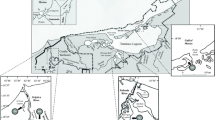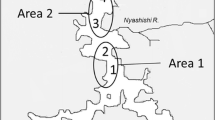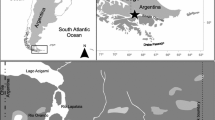Abstract
Nitrogen inputs to coastal environments can considerably alter the abundance of primary producers. However, how herbivores modify their trophic signatures and adjust to changes in food resource conditions remains controversial. Here, we assess the effect of nutrient availability on the diet shifts of the two main Mediterranean herbivores, the Sparid fish Sarpa salpa L. and the sea urchin Paracentrotus lividus (Lmk.) that feed mostly on the seagrass Posidonia oceanica L. (Delile), epiphytes and benthic macroalgae. To do this, we (1) investigate the patterns of isotopic composition (δ13C and δ15N signatures) of the two herbivores and their potential food sources in three areas of contrasting nutrient conditions and, (2) we assess the diet shift along this nutrient gradient by estimating the isotopic nutrient enrichment (i.e., the contribution of δ13C and δ15N signatures in consumers’ tissues relative to potential food sources). Food web signatures of δ13C were similar among the three study sites, and no patterns of δ13C shift were observed in their diets. In contrast, there was a consistent increase in N contents and δ15N along the nutrient gradient for all primary producers and their consumers. The rate of δ15N enrichment was also clearly distinctive between the two herbivores: in P. lividus it increased by 61% along the nutrient gradient, while in S. salpa it remained constant. Our results suggest that sea urchins behave as facultative omnivores and feed on vegetable or mixed diets depending on the trophic status of the system. It is unclear, however, if this modification is behavioral or the consequence of mere changes in the availability of food items, as animal epiphytes (e.g., hydrozoans, bryozoans and ascidians) can also became more abundant on seagrass leaves under increased nutrient conditions. In contrast, adult fish appear to feed on vegetal material independent of nutrient availability in the ecosystem.





Similar content being viewed by others
References
Alcoverro T, Cebrián E, Ballesteros E (2001) The photosynthetic capacity of the seagrass Posidonia oceanica: influence of nitrogen and light. Mar Ecol Prog Ser 261:107–120
Alcoverro T, Pérez M, Romero J (2004) Importance of within-shoot epiphyte distribution for the carbon budget of seagrasses: the example of Posidonia oceanica. Bot Mar 47:307–312
Azzurro E, Fanelli E, Mostarda E, Catra M, Andaloro F (2007) Resource partitioning among early colonizing Siganus luridus and native herbivorous fishes in Mediterranean: an integrated study based on gut-content analysis and stable isotope signatures. J Mar Biol Assoc UK 87:991–998
Ballesteros E (1992) Els vegetals i la zonació litoral: èspecies, comunitats i factors que influeixen en la seva distribució. Institut d’Estudis Catalans. Seció de Ciències Biològiques II Collecció III, Fitogeografia Costa Brava, p 616
Ballesteros E, Zabala M (1993) El bentos: el marc físic. In: Alcover JA, Ballesteros E, Fornós JJ (eds) Història Natural de l’arxipèlag de Cabrera. Monografies de la Societat d’Història Natural de Balears, vol 2. CSIC-Ed, Palma de Mallorca, pp 663–685
Bjorndal KA (1980) Nutrition and grazing behavior of the green turtle Chelonia mydas. Mar Biol 56:147–154
Bosc E, Bricaud A, Antoine D (2004) Seasonal and interannual variability in algal biomass and primary production in the Mediterranean Sea, as derived from 4 years of SeaWiFS observations. Glob Biochem Cycles 18, Art No. GB1005. doi:10.1029/2003GB002034
Brett JR, Zala CA (1975) Daily pattern of nitrogen excretion and oxygen consumption of Sockeye Salmon (Oncorhynchus nerka) under controlled conditions. J Fish Res Board Can 32:2479–2486
Brockington S, Clarke A (2001) The relative influence of temperature and food on the metabolism of a marine invertebrate. J Exp Mar Biol Ecol 258:87–99
Bunn SE, Loneregan NR, Kempster MA (1995) Effects of acid washing on stable isotope radios of C and N in penaeid shrimp and seagrasses: implications for food-web studies using multiple stable isotopes. Limnol Oceanogr 40:622–625
Campbell JE, Fourqurean JW (2009) Interspecific variation in the elemental and stable isotopic content of seagrass communities in South Florida. Mar Ecol Prog Ser 387:109–123
Cardona L, Aguilar A, Pazos L (2009) Delayed ontogenic dietary shift and high levels of omnivory in green turtles (Chelonia mydas) from the NW coast of Africa. Mar Biol 156(7):1487–1495
Casola E, Scardi M, Mazzella L, Fresi E (1987) Structure of the epiphytic community of Posidonia oceanica leaves in a shallow meadow. PSZN: Mar Ecol 8:285–296
Cebrián J, Duarte CM, Marbà N, Enríquez S, Gallegos M, Olesen B (1996) Herbivory on Posidonia oceanica: magnitude and variability in the Spanish Mediterranean. Mar Ecol Prog Ser 130:147–155
Cooper LW, DeNiro MJ (1989) Stable carbon isotope variability in the seagrass Posidonia oceanica: evidence for light intensity effects. Mar Ecol Prog Ser 50:225–229
Crawley KR, Hyndes GA, Vanderklift MA (2007) Variation among diets in discrimination of δ13C and δ15N in the amphipod Allorchestes compressa. J Exp Mar Biol Ecol 349:370–377
de la Morinière EC, Pollux BJA, Nagelkerken I, Hemminga MA, Huiskes AHL, van der Velde G (2003) Ontogenetic dietary changes of coral reef fishes in the mangrove-seagrass-reef continuum: stable isotopes and gut-content analysis. Mar Ecol Prog Ser 246:279–289
Deegan LA, Wright A, Ayvazian SG, Finn JT, Golden H, Merson RR, Harrison J (2002) Nitrogen loading alters seagrass ecosystem structure and support of higher trophic levels. Aquat Conserv: Mar Freshw Ecosist 12:193–212
DeNiro MJ, Epstein S (1978) Influence of diet on the distribution of carbon isotopes in animals. Geo Cosm Acta 42:495–506
DeNiro MJ, Epstein S (1981) Influence of diet on the distribution of nitrogen isotopes in animals. Geo Cosm Acta 45:341–351
Duarte CM (1992) Nutrient concentration of aquatic plants: patterns across species. Limnol Oceanogr 37:882–889
Duarte CM, Cebrián J (1994) The fate of marine autotrophic production. Limnol Oceanogr 41:1758–1766
Estrada M (1996) Primary production in the northwestern Mediterranean. Sci Mar 60:55–64
Estrada M, Margalef R (1988) Supply of nutrients to the Mediterranean photic zone along a persistent front. Oceanol Acta 9(Spec issue):133–142
Fernandez C, Boudouresque CF (1998) Evaluating artificial diets for small Paracentrotus lividus (Echinodermata: Echinoidea). In: Mooi R, Telford M (eds) Echinoderms: San Francisco. Balkema, Rotterdam, pp 651–656
Fernandez C, Boudouresque CF (2000) Nutrition of the sea urchin Paracentrotus lividus (Echinodermata: Echinoidea) fed different artificial food. Mar Ecol Prog Ser 204:131–141
Fernandez C, Caltagirone A (1998) Comportement alimentaire de Paracentrotus lividus (Echinodermata: Echinoidea) en milieu lagunaire. Rapp Comm Int Mer Médit 35:538–539
Fourqurean JW, Jones RD, Zieman JC (1993) Processes influencing water column nutrient characteristics and phosphorus limitation of phytoplankton biomass in Florida Bay, FL, USA: inferences from spatial distributions. Estuar Coast Shef Sci 36:295–314
Fry B (1988) Foodweb structure on georges bank from stable C, N, and S isotopic compositions. Limnol Oceanogr 33:1182–1190
Gacia E, Costalago D, Prado P, Piorno D, Tomas F (2009) Mesograzers in P. oceanica meadows: an update of data on gastropod -epiphyte- seagrass interactions. Bot Mar 52:439–447
Gaye-Siessegger J, Focken U, Abel HJ, Becker K (2003) Feeding level and diet quality influence trophic shift of C and N isotopes in Nile Tilapia (Oreochromis nicoticus (L.)). Isotop Environ Health Stud 39:125–134
Gaye-Siessegger J, Focken U, Muetzel S, Abel HJ, Becker K (2004) Feeding level and individual metabolic rate affect δ13C and δ15N values in carp: implications for food web studies. Oecologia 138:175–183
Gili J-M, Coma R (1998) Benthic suspension feeders: their paramount role in littoral marine food webs. Trends Ecol Evol 13:316–321
Godley BJ, Thompson DR, Waldron S, Furness RW (1998) The trophic status of marine turtles as determined by stable isotope analysis. Mar Ecol Prog Ser 166:277–284
Goto M, Ito C, Sani Yahaya M, Wakamura K, Asano S, Wakai Y, Oka Y, Furuta M, Kataoka T (2004) Effects of age, body size and season on food consumption and digestion of captive dugongs (Dugong dugon). Mar Fresh Behav Physiol 37:89–97
Greenstone MH (1979) Spider feeding behaviour optimises dietary essential amino acid composition. Nature 282:501–503
Harrigan P, Zieman JC, Macko SA (1989) The base of nutritional support for the gray snapper (Lutjanus griseus): an evaluation based on a combined stomach content and stable isotope analysis. Bull Mar Sci 44:65–77
Havelange S, Lepoint G, Dauby P, Bouquegnau JM (1997) Feeding of the sparid fish Sarpa salpa in a seagrass ecosystem: diet and carbon flux. PSZN: Mar Ecol 18:289–297
Hobson KA, Alisauskas RT, Clark RG (1993) Stable-nitrogen isotope enrichment in avian tissues due to fasting and nutritional stress: implications for isotopic analysis of diet. Condor 95:388–394
Holmer M, Marba N, Diaz-Almela E, Duarte CM, Tsapakis M, Danovaro R (2007) Sedimentation of organic matter from fish farms in oligotrophic Mediterranean assessed through bulk and stable isotope (δ13C and δ15N) analyses. Aquaculture 262:268–280
Jadot C, Ovidio M, Voss J (2002) Diel activity of Sarpa salpa (Sparidae) by ultrasonic telemetry in a Posidonia oceanica meadow of Corsiga (Mediterranean Sea). Aquat Living Resour 15:343–350
Jennings S, Renones O, Morales-Nin B, Polunin NVC, Moranta J, Coll J (1997) Spatial variation in the 15N and 13C stable isotope composition of plants, invertebrates and fishes on Mediterranean reefs: implications for the study of trophic pathways. Mar Ecol Prog Ser 146:109–116
Jobling M (1981) The influences of feeding on the metabolic rate of fishes: a short review. J Fish Biol 18:385–400
Kupfer A, Langel R, Scheu S, Himstedt W, Maraun M (2006) Trophic ecology of a tropical aquatic and terrestrial food web: insights from stable isotopes (15N). J Trop Ecol 22:469–476
Lapointe BE, Barile PJ, Matzie WR (2004) Anthropogenic nutrient enrichment of seagrass and coral reef communities in the lower Florida Keys: discrimination of local versus regional nitrogen sources. J Exp Mar Biol Ecol 208:23–58
Marguillier S, Van der Velde G, Dehairs F, Hemminga MA, Rajagopal S (1997) Trophic relationships in an inter-linked mangrove-seagrass ecosystem as traced by δ13C and δ15N. Mar Ecol Prog Ser 151:115–121
McGlathery KJ (1995) Nutrient and grazing influences on a subtropical seagrass community. Mar Ecol Prog Ser 122:239–252
McGlathery KJ (2001) Macroalgal blooms contribuye to the decline of seagrass in nutrient-enriched coastal waters. J Phycol 37:453–456
Minagawa M, Wada E (1984) Stepwise enrichment of 15N along food chains: further evidence and the relation between 15N and animal age. Geochim Cosmoch Acta 48:1135–1140
Oelbermann K, Scheu S (2002) Stable isotope enrichment (δ15N and δ13C) in a generalist predator (Pardosa lugubris, Araneae: Lycosidae): effects of prey quality. Oecologia 130:337–344
Phillips DL, Koch PL (2002) Incorporating concentration dependence in stable isotope mixing models. Oecologia 130:114–125
Pinna S, Pais A, Chessa L, Sechi N, Ceccherelli G (2009) Spatial variation of Paracentrotus lividus and Sarpa salpa herbivory on Posidonia oceanica seagrass meadows. Estuar Coast Shelf Sci 84(1):21–27
Pinnegar JK, Polunin NVC (2000) Contributions of stable-isotope data to elucidating food webs of Mediterranean rocky fishes. Oecologia 122:399–409
Post DM (2002) Using stable isotopes to estimate trophic position: models, methods, and assumptions. Ecology 83:703–718
Prado P (2007) Magnitude of herbivory in Posidonia oceanica and factors responsible for spatial variation. Ph.D.thesis, Univ of Barcelona
Prado P, Tomas F, Alcoverro T, Romero J (2007a) Extensive direct measurements of Posidonia oceanica defoliation confirm the importance of herbivory in temperate seagrass meadows. Mar Ecol Prog Ser 340:63–71
Prado P, Alcoverro T, Martínez-Crego B, Vergés A, Pérez M, Romero J (2007b) Macrograzers strongly influence patterns of epiphytic assemblages in seagrass meadows. J Exp Mar Biol Ecol 350:130–143
Robbins CT, Felicity LA, Sponheimer M (2005) The effect of dietary protein quality on nitrógeno isotope discrimination in mammals and birds. Oecologia 144:534–540
Robinson D (2001) δ15N as an integrator of the nitrogen cycle. Trends Ecol Evol 16:153–162
Romero J, Martínez-Crego B, Alcoverro T, Pérez M (2007) A multivariate index based on the seagrass Posidonia oceanica (POMI) to assess ecological status of coastal waters under the water framework directive (WFD). Mar Poll Bull 55:196–204
Steele KW, Daniel RM (1978) Fractionation of nitrogen isotopes by animals: a further complication to the use of variations in the natural abundance of 15N for tracer studies. J Agric Sci 90:7–9
Sutoh M, Koyama T, Yoneyama T (1987) Variations of natural 15N abundances in the tissues and digesta of domestic animals. Radioisotopes 36:74–77
Sweeting CJ, Barry JT, Polunin NVC, Jennings S (2007) Effects of body size and environment of diet-tissue δ13C fractionation in fishes. J Exp Mar Biol Ecol 352:165–176
Tenore KR (1977) Growth of Capitella capitata cultured on various levels of detritus derived from different sources. Limnol Oceanogr 22:936–941
Tomas F, Turon X, Romero J (2005) Seasonal and small-scale spatial variability of herbivory pressure on the temperate seagrass Posidonia oceanica. Mar Ecol Prog Ser 301:95–107
Tomas F, Alvarez-Cascos D, Turon X, Romero J (2006) Differential element assimilation by sea urchins Paracentrotus lividus in seagrass beds: implications for trophic interactions. Mar Ecol Prog Ser 306:125–131
Vanderklift MA, Ponsard S (2003) Sources of variation in consumer diet 15N enrichment: a meta-analysis. Oecologia 136:169–182
Vanderklift MA, Kendrick GA, Smit AJ (2006) Differences in trophic position among sympatric sea urchin species. Estuar Coast Shelf Sci 66:291–297
Velimirov B (1984) Grazing of Sarpa salpa (L.) on Posidonia oceanica and utilization of soluble compounds. In: Boudouresque CF, de Grissac J, Olivier J (eds) International workshop Posidonia oceanica beds, vol 1. GIS Posidonie publ, France, pp 381–387
Verlaque M (1981) Preliminary data on some Posidonia oceanica feeders. Rapp Comm Int Mer Medit 27:201–202
Vizzini S, Mazzola A (2004) Stable isotope evidence for the environmental impact of a land-based fish farm in the western Mediterranean. Mar Poll Bull 49:61–70
Wear DJ, Sullivan MJ, Moore AD, Millie DF (1999) Effects of water-column enrichment on the production dynamics of three seagrass species and their epiphytic algae. Mar Ecol Prog Ser 179:201–213
Williams SL (1988) Thalassia testudinum productivity and grazing by green turtles in a highly disturbed seagrass bed. Mar Biol 98:447–455
Wolf N, Carleton SA, Martínez del Rio C (2009) Ten years of experimental animal isotopic ecology. Funct Ecol 23:17–26
Acknowledgments
This work was supported by a FI scholarship from the Departament d’Universitats, Recerca i Societat de la Informació (DURSI, Generalitat de Catalunya) and CGL2007-66771-C02-01/CGL2009-12562 grants from the Spanish Ministry of Science and Technology. Isotope and element analyses were performed at the Serveis Científico-Tècnics de la Universitat de Barcelona.
Author information
Authors and Affiliations
Corresponding author
Additional information
Communicated by S. D. Connell.
Rights and permissions
About this article
Cite this article
Prado, P., Alcoverro, T. & Romero, J. Influence of nutrients in the feeding ecology of seagrass (Posidonia oceanica L.) consumers: a stable isotopes approach. Mar Biol 157, 715–724 (2010). https://doi.org/10.1007/s00227-009-1355-2
Received:
Accepted:
Published:
Issue Date:
DOI: https://doi.org/10.1007/s00227-009-1355-2




